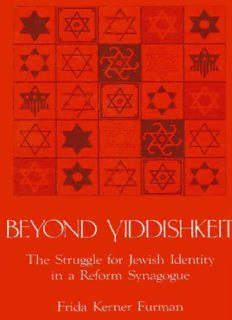
Beyond Yiddishkeit: The Struggle for Jewish Identity in a Reform Synagogue PDF
Preview Beyond Yiddishkeit: The Struggle for Jewish Identity in a Reform Synagogue
Beyond Yiddishkeit SUNY Series in Anthropology and Judaic Studies Walter P. Zenner, Editor Beyond Yiddishkeit The Struggle for Jewish Identity in a Reform Synagogue FRIDA KERNER FURMAN State University of New York Press Published by State University of New York Press, Albany ©1987 State University of New York All rights reserved Printed in the United States of America No part of this book may be used or reproduced in any manner whatsoever without written permission except in the case of brief quotations embodied in critical articles and reviews. For information, address State University of New York Press, State University Plaza, Albany, N.Y., 12246 Lihrary of Congress Cataloging in Publication Data Furman, Frida Kerner, 1948- Beyond Yiddishkeit. (SUNY series in anthropology and Judaic studies) Bibliography: p. 143 Includes index. 1. Judaism-United States. 2. Reform Judaism-United States. 3. Jews-United States-Identity. 1. Title. II. Series. BM205.F87 1987 2.96.8'346'0973 86-29999 ISBN 0-88706-513-9 ISBN 0-88706-514-7 (pbk.) TaRoy Contents Acknowledgments IX Introduction 1 1. The Transformation ofJ ewish Identity 9 Traditional Jewish Society 10 The Religious Dimension 10 The Individual and the Group 12 The Power of the Past 13 The Move to Modernity 14 The Dissolution of Traditional Jewish Society 14 Alternative Jewish Paths 16 The American Experience 19 Tradition and Modernity: A False Dichotomy 23 2. Temple Shalom: Setting and Reform Context 27 Temple Shalom Today 28 The Membership 28 Professional Staff 29 Organizational Structure 29 The Religious School 30 The Reform Movement in America 31 3. Ideology and Identity 41 Liberalism 41 Social Activism 51 The Jewish Tradition 52 The Yarmulke Controversy 53 The Question of Jewish Content 56 Summary and Conclusions 61 Contents 4. Ritual and Identity 65 The Ritual Context 66 The Sabbath Service 68 The Prayerbook 68 The Normative Ritual 73 The Chaverim Service: Ritual of Reversal 85 Analysis 87 5. Community and Identity 97 The Construction of Community: Uniqueness and Identity 99 The Temple Shalom Family 100 Differentiation from the Jewish Community 101 Style 105 Temple Shalom as Community 110 6. Conclusions 119 The Sacralization of Identity 119 The Liberal Ethic 121 Universalism and Individualism 121 Rationality 126 Secularism 128 The Construction of a New Ethic 130 Notes 135 Glossary 141 Bibliography 143 Index 155 Acknowledgments I would like to thank the people of Temple Shalom-members, clergy, and staff-for making this study possible. Beyond that, however, I want to thank them for their hospitality, warmth, and generosity. I learned much from Temple Shalom, not only about how a synagogue structures Jewish meaning for its members, but also how its inhabitants give meaning to each other's lives. This is a community of people who genuinely care for each other: They taught me a great deal about the human possibilities of organized religion. Many individuals generously provided encouragement and suggestions at various stages of this study. I wish to thank Stanley Chyet, David Ellenson, Donald E. Miller, Norman Mirsky, the late Barbara Myerhoff, John B. Orr, Riv-Ellen Prell, and the four anonymous readers designated by the State University of New York Press. I am deeply grateful to Jane Monnig Atkinson for her friendship, unswerving support, and thorough critique of the manuscript in the last stages of revision. I also thank my editor at SUNY Press, Rosalie Robertson, and the series editor, Walter Zenner, for their suggestions. Of course, I take full responsiblity for the interpretations offered herein. Shulamit Levine's skills on the word processor are most appreciated. I gratefully acknowledge the support of the Memorial Foundation for Jewish Culture, which provided me with a grant in the initial stages of this project. My husband, Roy Furman, was a marvelous counselor, critic, editor, and child-care provider-as the needs arose-throughout the time that this book was in process. The dedication is a small gesture of my appreciation. IX
Description: